Lightning Ridge
Lightning Ridge on Google maps. View larger map.
Lightning Ridge is situated in north central New South Wales not far from the Queensland border. Opal mining has been the major attraction for migrants from within Australia and around the world since the first finds in the early 1900s. Typically it attracts those interested in working for themselves and an independent lifestyle. Amongst a population of around 7,000 more than 50 different countries of origin are represented.
The World in Lightning Ridge

Map representing the nationalities in Lightning Ridge in 2006. Detail, Introduction, panel two, Migration Memories: Lighting Ridge. Design: Iona Walsh.
Local migration history in the Migration Memories exhibitions
Pastoral colonisation, the displacement of Indigenous people and the attraction of opal mining were seen as the main elements of Lightning Ridge's particular migration history. Research also identified distinct forms of migration shaped by Australian immigration history more generally and the development of Lightning Ridge as a town. In the exhibitions a timeline juxtaposed key migration events in Australia with local developments.
A personal migration story was developed for each significant migration context.
Colonial pastoral migrations
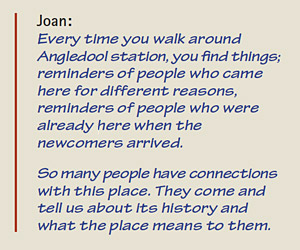 |
||
| Detail, Joan Treweeke, object caption, Migration Memories: Lightning Ridge. Design: Iona Walsh |
In the mid 1800s, country in the area which includes Lightning Ridge was gradually taken up for pastoral use by British colonists. Amongst those who followed the British were Chinese labourers who often worked on pastoral stations as gardeners. Other pastoral workers were local Indigenous people, the Yuwaalaraay.
Joan Treweeke’s story highlighted the experience of the British pastoralists and the Chinese and Indigenous workers on Angledool station.
Go to Joan Treweeke >
The Indigenous experience
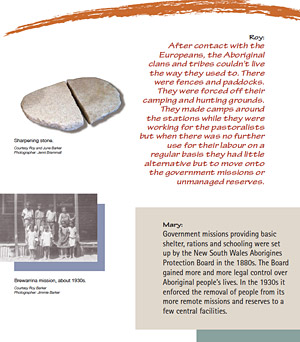 |
|
| Detail, June and Roy Barker, panel one, Migration Memories: Lightning Ridge. Design: Iona Walsh. |
When the land in and around Lighting Ridge was taken for pastoral activity, the Yuwaalaraay lost their way of life. At first they were able to stay on their traditional lands by working for the pastoralists but gradually they were moved to government settlements. In 1936 those who had been living at the settlement at nearby Angledool, since 1912, were forcibly removed from their country to Brewarrina. At around the same time, Indigenous people in the region started to see opal mining as an alternative to pastoral labour. Since the 1930s people from various tribal backgrounds, including Yuwaalaraay, have found a home in Lightning Ridge.
June and Roy Barker grew up on Brewarrina Mission in the 1930s. Like the Yuwaalaraay people who were taken there, they were also far from their tribal countries.
Go to Aunty June and Uncle Roy Barker >
Early opal mining migrations
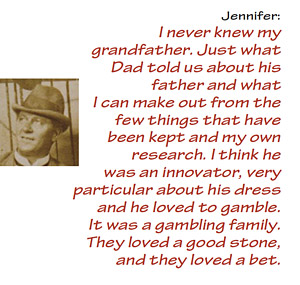 |
|
| Detail, Jennifer Colless, panel two, Migration Memories: Lightning Ridge. Design: Iona Walsh. |
The first opal rushes to Lightning Ridge attracted people from many different cultural backgrounds. As with other Australian opal fields, German opal traders played an influential role until the relationship between Germany and Australia came to an end with the First World War (1914-1918). A number of the original miners trekked east from the failing fields at White Cliffs. There was little change in the pattern of arrivals and departures through the two world wars and the Great Depression.
Jennifer Colless’s story focused on her German grandfather who brought his family to Lighting Ridge from White Cliffs in 1909. The family continued their business into the 1950s.
Go to Jennifer Colless >
Australia’s post-war immigration program and the 1960s development of Lightning Ridge
The seeds of a new wave of immigrants to Lighting Ridge were sown by the Commonwealth Government’s support of mass immigration from Europe in the aftermath of the Second World War. During the 1960s and 70s, people from all corners of Europe and, as immigration expanded, from Turkey and Lebanon found their way to Lightning Ridge. Eastern Europeans, particularly from the former Yugoslavia, were one of the largest groups. This was an era of development and expansion for the town. It was connected to electricity and artesian bore water, and a bitumen road was built. There was greater mechanisation of mining and a new opal market was opened up with Japan.
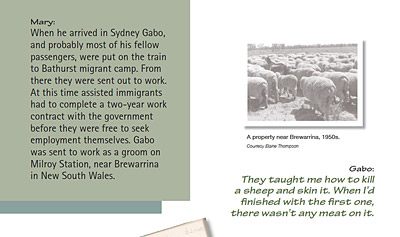 |
||
| Detail, Gabor Nagy, panel three, Migration Memories: Lightning Ridge. Design: Iona Walsh. |
When Gabor Nagy came to Australia as a refugee from Hungary in 1949 he worked in the pastoral industry. In the 1960s he got a job at the Lightning Ridge pub and moved his family into town.
Go to Gabor and Sheila Nagy >
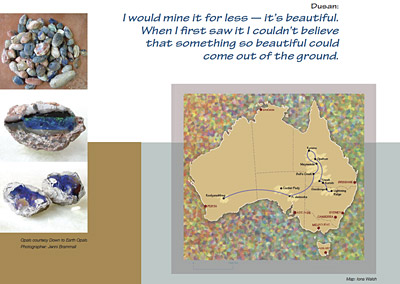 |
||
| Detail, Dusan Malinovic, panel two, Migration Memories: Lightning Ridge. Design: Iona Walsh. |
When he arrived in Australia from the former Yugoslavia in 1963, Dusan Malinovic worked in the mining and construction industries. Opal mining offered an independent way of earning a living. He settled in Lightning Ridge in 1973.
Go to Dusan Malinovic >
Immigration since the 1980s
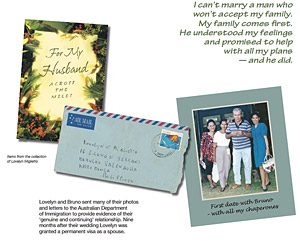 |
|
| Detail, Lovelyn Miglietta, panel 2, Migration Memories: Lightning Ridge. Design: Iona Walsh. |
By the early 1980s migration to Australia had changed dramatically. Migrants were no longer selected on the basis of race or country of origin and the assisted migration program had been replaced by business migration, family reunion and refugee programs. One experience typical of the recent period in Lightning Ridge, is that of women coming to join Australian husbands under the spouse migration scheme. There is a growing Filipino community in Lightning Ridge based on this particular form of migration.
Lovelyn Miglietta came to Lightning Ridge from the Philippines to join her husband, an Australian citizen originally from Italy, in 1994. Since her arrival she has built up their grocery and Asian food business.
Go to Lovelyn Miglietta >
‘Sea change’ lifestyle migration
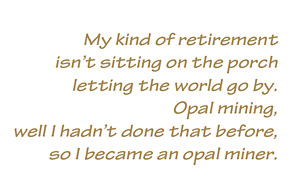 |
|
| Detail, Frans Persson, panel one, Migration Memories: Lightning Ridge. Design: Iona Walsh. |
Local community organisations see the advent of lifestyle migration to Lightning Ridge as a critical recent development for the locality. People who have visited over many years sometimes decide to retire to their mining lease. Others are attracted by the artesian baths and the independent lifestyle.
Frans Persson and his wife, who originally came to Australia from Sweden in the post-war period, decided to retire to Lightning Ridge in 1990.
Go to Frans Persson >
